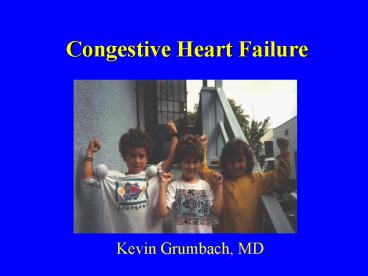Congestive Heart Failure - PowerPoint PPT Presentation
1 / 35
Title:
Congestive Heart Failure
Description:
Source: McCullough et al, J Am Coll Cardiol, 2002. Survival After ... ejection fraction 35-40% but signs and symptoms of CHF ... I use like a bouillon cube... – PowerPoint PPT presentation
Number of Views:553
Avg rating:3.0/5.0
Title: Congestive Heart Failure
1
Congestive Heart Failure
- Kevin Grumbach, MD
2
(No Transcript)
3
Incidence of CHF by Race(Detroit, MI 1989-1999)
W AA Other
W AA Other
W AA Other
W AA Other
Source McCullough et al, J Am Coll Cardiol, 2002
4
(No Transcript)
5
Survival After Diagnosis of CHF
66
Alive
50
33
Years After Diagnosis
6
2 Varieties of CHF
- Systolic dysfunction
- ejection fraction lt 35-40
- Diastolic dysfunction
- ejection fraction gt 35-40 but signs and symptoms
of CHF - Echocardiogram or Radionuclide Ventriculography
- aid in distinguishing
7
- Managing CHF
- Due to Systolic Dysfunction
- A physiologic approach
8
(No Transcript)
9
Counterproductive Responses toLow Cardiac Output
10
11
(No Transcript)
12
Diuretic Treatment
- Furosemide (20 mg qd - 240 mg bid)
- Improve symptoms ? survival effect
- Titrate vs. weight, pedal edema
- K
13
Major Technological Breakthrough in Care of CHF
14
Afterload Reduction (Vasodilators)
- ACE Inhibitors
- Angiotensin Receptor Blockers
- Hydralizine and Nitrate
- Improve both symptoms and survival
- ACEI benefit if low ejection fraction even
without overt CHF
15
ACE Inhibitors and CHF Survival
Died
Class IV (1 year)
Class II (3.5 years)
16
Blocking the effects of Neurohumoral Activation
- Beta-blockers
- Spironolactone
17
Carvedilol Study
Died
Median Duration Rx 6.5 months
NEJM 1996 3341349
18
CIBIS-II Trial Bisoprolol vs. Placebo 1.3 Year
Mortality
Number needed to treat 20 Source Lancet
19993539
19
Spironolactone vs. Placebo2 Year Mortality
(Class IV CHF)
Number needed to treat 9 Source NEJM
1999341709
20
Foxglove Digitalis Pupurea
21
Digoxin
- Mainly third-line agent
- Research evidence (as 3rd line Rx)
- 1. Symptoms worsen when digoxin D/Cd
- 2. May reduce hospitalizations,
- but not mortality
22
The Bottom LineSystolic Dysfunction
- ACE inhibitors first-line therapy (ARBs as
alternative) - Diuretics titrated to symptoms
- Beta-blocker
- Spironolactone if K tolerates
- Digoxin last resort
- Titrate ACEI, Beta-blocker to target doses
23
Improving Pump Functionwith Surgical Treatment
- Transplantation
- Artificial Heart
24
Managing CHF Due to Diastolic Dysfunction
- Less studied
- Improve LV compliance Rx HTN, LVH (beta
blockers, ACEI, ARB, Ca blocker) - Diuretics, low Na diet if volume overload
- Digoxin - no role
25
CHF and the Chronic Care Model
- Delivery system redesign Team care and Case
management - Self-management
- Registries
- Proactive monitoring
- Clinical Information systems
26
Qualitative Study of CHF Patients in NYC
- Patients had inadequate information about causes,
symptoms, management and consequences of CHF. - Patients did not appear to have the tools to
prevent, recognize, or act to address the
exacerbation of their conditions before their
conditions deteriorated quite significantly. - When symptoms worsened to the point where
patients were aware of danger, they tended to
have difficulty navigating systems and overcoming
barriers to receiving care outside of an
emergency room.
Source Horowitz CR et al. Soc Sci Med 200458631
27
- I never do use salt, since my pressure went
up on me years ago I dont use salt like when I
cook I use like a bouillon cube - If I was aware of how this CHF symptoms comes
about, I would probably try to prevent it. But I
am not aware
28
- When you hear about having heart problems,
youre supposed to feel maybe a pain in your
left arm, maybe a pain in your chest, or
pressure. I couldnt describe what I felt as
pressure but I guess it must have been that, uh
because I had to struggle in order to talk I
guess it would have been more clear to me if I
had chest pain and then I would have said okay,
Ill call and say Im having chest pain but it
didnt just seem to me like anything came
together where I could call.
29
Patient Model of CHF as Episodic Acute Illness
and Not Chronic Illness
Source Horowitz CR et al. Soc Sci Med 200458631
30
Model of CHF as Chronic Condition
Source Horowitz CR et al. Soc Sci Med 200458631
31
Harlem Nurse Management CHF Program
- RCT of patients in Harlem
- Recruited as outpatients
- Mean age 59
- 46 African American, 33 Latino
- Systolic dysfunction
- 60 NYHA Class III-IV
- Randomized to intervention of RN manager vs usual
care (N203 X 2)
Source Sisk JE et al. Ann Int Med 2006145273
32
RN Intervention
- Initial, 1-time in-person appointment
- Education, self-management counseling, prn social
service referral - Follow-up telephone calls
- Structured schedule (2, 4, 8, 12, 24 weeks) and
prn - Coordination with PCP
- Notes to PCP, Rx recommendations per protocol
33
12 Month OutcomesHospitalizations/person-year
Adjusted difference -.13 (-.25, -.001)
34
Quality of LifeHealth Status SF-12 Outcomes
35
Whats Your Chronic Care Model for Patients With
CHF at FHC?

